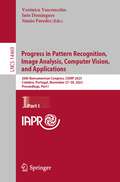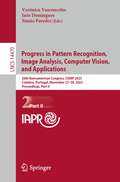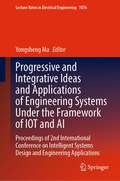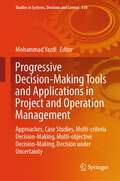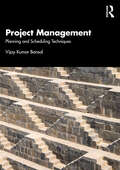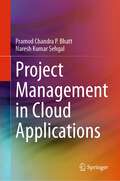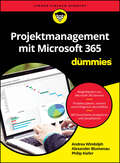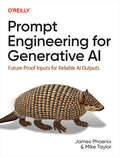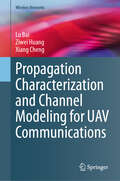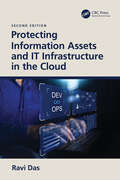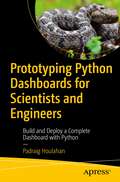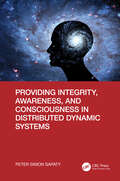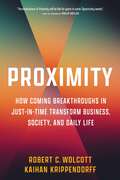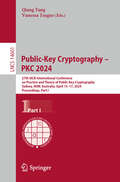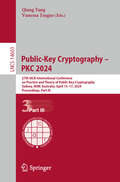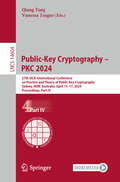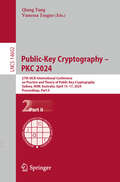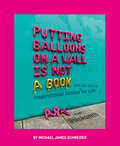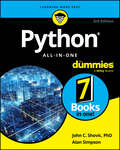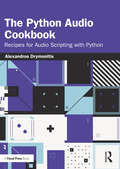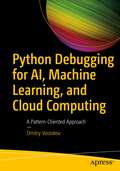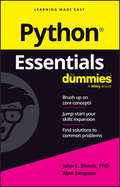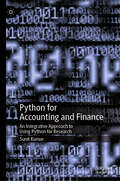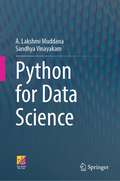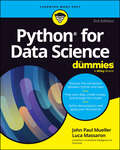- Table View
- List View
Progress in Pattern Recognition, Image Analysis, Computer Vision, and Applications: 26th Iberoamerican Congress, CIARP 2023, Coimbra, Portugal, November 27–30, 2023, Proceedings, Part I (Lecture Notes in Computer Science #14469)
by Verónica Vasconcelos Inês Domingues Simão ParedesThis 2-volume set, LNCS 14469 and 14470, constitutes the proceedings of the 26th Iberoamerican Congress on Progress in Pattern Recognition, Image Analysis, Computer Vision, and Applications, CIARP 2023, which took place in Coimbra, Portugal, in November 2023. The 61 papers presented were carefully reviewed and selected from 106 submissions. And present research in the fields of pattern recognition, artificial intelligence, and related areas.
Progress in Pattern Recognition, Image Analysis, Computer Vision, and Applications: 26th Iberoamerican Congress, CIARP 2023, Coimbra, Portugal, November 27–30, 2023, Proceedings, Part II (Lecture Notes in Computer Science #14470)
by Verónica Vasconcelos Inês Domingues Simão ParedesThis 2-volume set, LNCS 14469 and 14470, constitutes the proceedings of the 26th Iberoamerican Congress on Progress in Pattern Recognition, Image Analysis, Computer Vision, and Applications, CIARP 2023, which took place in Coimbra, Portugal, in November 2023. The 61 papers presented were carefully reviewed and selected from 106 submissions. And present research in the fields of pattern recognition, artificial intelligence, and related areas.
Progressive and Integrative Ideas and Applications of Engineering Systems Under the Framework of IOT and AI: Proceedings of 2nd International Conference on Intelligent Systems Design and Engineering Applications (Lecture Notes in Electrical Engineering #1076)
by Yongsheng MaThis volume of proceedings contains peer reviewed papers presented at 2023 International Conference on Intelligent Systems Design and Engineering Applications which was held in Okayama, Japan, May 12-14, 2023 (ISDEA2023). There are five major sessions covered in this book, including 1) Theory and Application of Artificial Intelligence Technologies in Industry; 2) System Design and Data Analysis within the Context of Internet of Things (IOT) ; 3) System Automation, Control, and Robots; 4) Smart Product Design and Integrated Manufacturing and 5) Sensors, Transducers and detection technology. This conference provides an idea-exchange and discussion platform for the world's engineers and academia to share cutting-edge information, address the hottest issue in intelligent systems design and engineering applications, explore new technologies, exchange and build upon ideas.
Progressive Decision-Making Tools and Applications in Project and Operation Management: Approaches, Case Studies, Multi-criteria Decision-Making, Multi-objective Decision-Making, Decision under Uncertainty (Studies in Systems, Decision and Control #518)
by Mohammad YazdiIn today's complex operational environments, leveraging advanced decision-making tools becomes imperative, particularly in uncertain scenarios. This book deepens the nuances of employing state-of-the-art decision-making methodologies within various industrial sectors for optimal project and operations management. The essence of integrating these advanced tools is to equip professionals with pivotal insights for cost-effective management and to strategize against potential operational shortcomings. Furthermore, the methodologies elucidated provide a robust foundation for crafting informed, risk-centric strategies that uphold the integrity of operations across diverse application domains. Readers will discover a rich tapestry of methodologies tailored for engineers and analysts. Deeply rooted in mathematical modeling, these approaches are complemented by human judgment and participation. Fundamental attributes of these methods include the evaluation of alternatives, benchmarking againstcriteria, assigning scores based on varying requirements, and assigning weights to denote the significance of individual criteria vis-à-vis others. The book embarks on a structured journey, commencing with a comprehensive review of evolving decision-making methodologies in project and operations management, enriched by metadata analysis. Subsequent chapters are meticulously organized, each spotlighting a distinct approach. Topics span foundational concepts in decision-making, the nuances of performance metrics in the digital age, and the implications of emerging technologies on operations management. Targeted towards professionals and researchers immersed in project and operations management, this work will also immensely benefit postgraduate and undergraduate students in related fields. Moreover, its relevance extends to professionals across diverse sectors, from oil and gas, marine and offshore, and renewable energies to chemical complexes, manufacturing, and healthcare systems.
Project Management: Planning and Scheduling Techniques
by Vijay Kumar BansalProject Management:Planning and Scheduling Techniques is a highly readable guide to the essentials of project planning, scheduling, and control aimed at readers looking for an introduction to the core concepts of planning and scheduling, including the ‘Critical Path Method’, but also the ‘Precedence Diagramming Method’, the ‘Line of Balance’ technique, and the ‘Programme Evaluation and Review Technique’. This book explains the theory behind the methods and makes effective use of learning outcomes, exercises, diagrams, and examples to provide clear and actionable knowledge for students and project managers. The book can be used as a classroom textbook or as a self-study guide for project managers taking their professional qualifications, and it includes examples from a wide range of project management scenarios. It is suitable for planning and scheduling courses in the fields of industrial, civil, and mechanical engineering, construction, and management.
Project Management in Cloud Applications
by Pramod Chandra Bhatt Naresh Kumar SehgalCloud Computing has been in use for several decades now, but the art and science of delivering Cloud based products is still shrouded in mystery. This book shines new light on how to deliver projects on time and within budget. The authors discuss the theory and practices of software engineering as applied to successful project execution, with real, Cloud-based products.
Projektmanagement mit Microsoft 365 für Dummies (Für Dummies)
by Andrea Windolph Alexander Blumenau Philip KieferSchritt für Schritt zum erfolgreichen Projekt In diesem Buch erfahren Sie, wie die Funktionen von Excel und weiteren Microsoft-365-Programmen Sie beim Initiieren, Planen und Überwachen von Projekten unterstützen. Von der Risikoanalyse bis zu Prognoserechnungen: Lernen Sie typische Projektmanagement-Methoden kennen und erfahren Sie insbesondere, wie Sie Informationen und Daten mit Excel aufbereiten, ansprechend visualisieren und anschließend vor Auftraggeber und Team präsentieren. Auch die Verwaltung von Aufgaben sowie die digitale Zusammenarbeit mithilfe von OneDrive und Microsoft Teams kommen nicht zu kurz. Sie erfahren Wie Sie Termine, Ressourcen und Kosten planen Wie Sie Fortschritte messen, Berichte erstellen und den Projektabschluss gestalten Welche Microsoft-365-Tools die Zusammenarbeit bei Projekten erleichtern Wie Sie Daten ansprechend visualisieren
Prompt Engineering for Generative AI
by James Phoenix Mike TaylorLarge language models (LLMs) and diffusion models such as ChatGPT and Stable Diffusion have unprecedented potential. Because they have been trained on all the public text and images on the internet, they can make useful contributions to a wide variety of tasks. And with the barrier to entry greatly reduced today, practically any developer can harness LLMs and diffusion models to tackle problems previously unsuitable for automation.With this book, you'll gain a solid foundation in generative AI, including how to apply these models in practice. When first integrating LLMs and diffusion models into their workflows, most developers struggle to coax reliable enough results from them to use in automated systems. Authors James Phoenix and Mike Taylor show you how a set of principles called prompt engineering can enable you to work effectively with AI.Learn how to empower AI to work for you. This book explains:The structure of the interaction chain of your program's AI model and the fine-grained steps in betweenHow AI model requests arise from transforming the application problem into a document completion problem in the model training domainThe influence of LLM and diffusion model architecture—and how to best interact with itHow these principles apply in practice in the domains of natural language processing, text and image generation, and code
Propagation Characterization and Channel Modeling for UAV Communications (Wireless Networks)
by Xiang Cheng Ziwei Huang Lu BaiThis book focuses on the propagation characterization and channel modeling of Unmanned Aerial Vehicle (UAV) communications. Currently, there are no books that cover this specific topic. The authors fill in this void by elaborating accurate yet easy-to-use UAV channel models. The authors also present such topics as propagation characteristics of UAV communications, a time stationary regular-shaped geometry-based stochastic model (RS-GBSM) for UAV narrowband channels. It also introduces a time non-stationary RS-GBSM for UAV narrowband channels, a time non-stationary RS-GBSM for UAV wideband channels, a time-space non-stationary irregular-shaped geometry-based stochastic model (IS-GBSM) for UAV wideband channels and more. Finally, this book closes up with some promising directions, hoping to promote future research outcomes in the field of UAV channel modeling. As the UAV technology matures rapidly, UAV communications are shifting from military development to civilian and commercial sectors. The UAV communication is widely considered as a significant and indispensable component of wireless communications. It is well known that an accurate yet easy-to-use UAV channel model is the foundation of designing a proper UAV communication system and evaluating its performance. This book also provides valuable suggestions for the design of UAV communication systems by adequately presenting the UAV propagation characterization and channel modeling. This book is mainly written for researchers and professionals working in wireless communications. Advanced-level students majoring in computer science or electrical engineering may also find the content useful as a secondary textbook.
Protecting Information Assets and IT Infrastructure in the Cloud
by Ravi DasThis book is a second edition. The last one reviewed the evolution of the Cloud, important Cloud concepts and terminology, and the threats that are posed on a daily basis to it. A deep dive into the components of Microsoft Azure were also provided, as well as risk mitigation strategies, and protecting data that resides in a Cloud environment. In this second edition, we extend this knowledge gained to discuss the concepts of Microsoft Azure. We also examine how Microsoft is playing a huge role in artificial intelligence and machine learning with its relationship with OpenAI. An overview into ChatGPT is also provided, along with a very serious discussion of the social implications for artificial intelligence.
Prototyping Python Dashboards for Scientists and Engineers: Build and Deploy a Complete Dashboard with Python
by Padraig HoulahanCreate interactive and data-driven dashboards using Python. This hands-on guide is a practical resource for those (with modest programming skills) in scientific and engineering fields looking to leverage Python's power for data visualization and analysis in a user-friendly dashboard format. You’ll begin by gaining a fundamental understanding of Python programming, including data types, lists, dictionaries, and data structures. The book then delves into the world of reactive programming with Plotly and Dash, offering a hands-on approach to building interactive web-based dashboards. Next, you’ll see how to work with online data, how to scrape and clean datasets, and keep files up-to-date. The book also guides you through planning a dashboard prototype, outlining project tasks, trends, forecasts, spectra, and other design considerations. It concludes with a discussion of how the dashboard can be used for data visualization of real data, explaining the usefulness of tools such as spectra. By providing detailed examples for download and customization, Prototyping Python Dashboards for Scientists and Engineers will equip you with the skills needed to jumpstart your own development efforts. What You’ll Learn Design a dashboard with PythonConvert and filter Excel formatted files to produce CSV filesCreate browser-served graphics with PLOTLYGenerate polynomial trend lines for forecastingBuild a Unix service to share your dashboard Who This Book Is For Scientists, engineers, students, programmers, and data enthusiasts who aspire to harness Python's potential for data visualization and analysis through the creation of interactive dashboards. Many will be pragmatic programmers with modest skills and limited resources who mainly want to see a working solution they could emulate.
Providing Integrity, Awareness, and Consciousness in Distributed Dynamic Systems
by Peter Simon SapatyThe ideas of this book originate from the mobile WAVE approach which allowed us, more than a half century ago, to implement citywide heterogeneous computer networks and solve distributed problems on them well before the internet. The invented paradigm evolved into Spatial Grasp Technology and resulted in a European patent and eight books. The volumes covered concrete applications in graph and network theory, defense and social systems, crisis management, simulation of global viruses, gestalt theory, collective robotics, space research, and related concepts. The obtained solutions often exhibited high system qualities like global integrity, distributed awareness, and even consciousness. This current book takes these important characteristics as primary research objectives, together with the theory of patterns covering them all. This book is oriented towards system scientists, application programmers, industry managers, defense and security commanders, and university students (especially those interested in advanced MSc and PhD projects on distributed system management), as well as philosophers, psychologists, and United Nations personnel.
Proximity: How Coming Breakthroughs in Just-in-Time Transform Business, Society, and Daily Life
by Kaihan Krippendorff Robert C. WolcottWhat if you could have whatever you want, produced and provided immediately and affordably no matter how customized—with minimal environmental impact? Products, services, and experiences on demand. Just-in-time anything, anywhere, anytime. This radical change is underway, as digital technologies push the production and provision of value ever closer to the moment of demand.Robert C. Wolcott and Kaihan Krippendorff provide an indispensable guide to the Proximity revolution, showing how it’s transforming every industry—and our lives. Offering unparalleled foresight for leaders and innovators, they reveal how pervasive this trend will be. Proximity represents an entirely new way to serve customers, with critical implications for corporate strategy, investing, public policy, supply chain resilience, and sustainability. Incremental changes to existing business models won’t suffice.Through interviews and compelling examples, Proximity shares stories of the people and companies leading the way. The book places rapidly advancing technologies—from generative AI and 3D printing to lab-grown meats, renewable energy, and virtual reality—in context and explores the factors accelerating the transformation.Proximity offers a playbook for business leaders, investors, and entrepreneurs to win this rapidly emerging game—and for each of us to consider the implications for our careers, families, communities, and lives.
Public-Key Cryptography – PKC 2024: 27th IACR International Conference on Practice and Theory of Public-Key Cryptography, Sydney, NSW, Australia, April 15–17, 2024, Proceedings, Part I (Lecture Notes in Computer Science #14601)
by Qiang Tang Vanessa TeagueThe four-volume proceedings set LNCS 14601-14604 constitutes the refereed proceedings of the 27th IACR International Conference on Practice and Theory of Public Key Cryptography, PKC 2024, held in Sydney, NSW, Australia, April 15–17, 2024. The 54 papers included in these proceedings were carefully reviewed and selected from 176 submissions. They focus on all aspects of signatures; attacks; commitments; multiparty computation; zero knowledge proofs; theoretical foundations; isogenies and applications; lattices and applications; Diffie Hellman and applications; encryption; homomorphic encryption; and implementation.
Public-Key Cryptography – PKC 2024: 27th IACR International Conference on Practice and Theory of Public-Key Cryptography, Sydney, NSW, Australia, April 15–17, 2024, Proceedings, Part III (Lecture Notes in Computer Science #14603)
by Qiang Tang Vanessa TeagueThe four-volume proceedings set LNCS 14601-14604 constitutes the refereed proceedings of the 27th IACR International Conference on Practice and Theory of Public Key Cryptography, PKC 2024, held in Sydney, NSW, Australia, April 15–17, 2024. The 54 papers included in these proceedings were carefully reviewed and selected from 176 submissions. They focus on all aspects of signatures; attacks; commitments; multiparty computation; zero knowledge proofs; theoretical foundations; isogenies and applications; lattices and applications; Diffie Hellman and applications; encryption; homomorphic encryption; and implementation.
Public-Key Cryptography – PKC 2024: 27th IACR International Conference on Practice and Theory of Public-Key Cryptography, Sydney, NSW, Australia, April 15–17, 2024, Proceedings, Part IV (Lecture Notes in Computer Science #14604)
by Qiang Tang Vanessa TeagueThe four-volume proceedings set LNCS 14601-14604 constitutes the refereed proceedings of the 27th IACR International Conference on Practice and Theory of Public Key Cryptography, PKC 2024, held in Sydney, NSW, Australia, April 15–17, 2024. The 54 papers included in these proceedings were carefully reviewed and selected from 176 submissions. They focus on all aspects of signatures; attacks; commitments; multiparty computation; zero knowledge proofs; theoretical foundations; isogenies and applications; lattices and applications; Diffie Hellman and applications; encryption; homomorphic encryption; and implementation.
Public-Key Cryptography – PKC 2024: 27th IACR International Conference on Practice and Theory of Public-Key Cryptography, Sydney, NSW, Australia, April 15–17, 2024, Proceedings, Part II (Lecture Notes in Computer Science #14602)
by Qiang Tang Vanessa TeagueThe four-volume proceedings set LNCS 14601-14604 constitutes the refereed proceedings of the 27th IACR International Conference on Practice and Theory of Public Key Cryptography, PKC 2024, held in Sydney, NSW, Australia, April 15–17, 2024. The 54 papers included in these proceedings were carefully reviewed and selected from 176 submissions. They focus on all aspects of signatures; attacks; commitments; multiparty computation; zero knowledge proofs; theoretical foundations; isogenies and applications; lattices and applications; Diffie Hellman and applications; encryption; homomorphic encryption; and implementation.
Putting Balloons on a Wall Is Not a Book: Inspirational Advice (and Non-Advice) for Life from @blcksmth
by Michael James SchneiderFrom viral balloon-word artist and Instagram sensation Michael James Schneider (@blcksmth) comes a one-of-a-kind debut gift book with never-before-seen original artwork!Featuring many of @blcksmth&’s most iconic balloon, flower, and light installations—plus exclusive new content—this book has a little something for everyone. Filled with funny, inspiring, and heartwarming messages on topics like self-love, self-growth, self-doubt, and advice for your future self, this is the perfect gift for any occasion or reader.
Python All-in-One For Dummies
by John C. Shovic Alan SimpsonEverything you need to know to get into Python coding, with 7 books in one Python All-in-One For Dummies is your one-stop source for answers to all your Python questions. From creating apps to building complex web sites to sorting big data, Python provides a way to get the work done. This book is great as a starting point for those new to coding, and it also makes a perfect reference for experienced coders looking for more than the basics. Apply your Python skills to data analysis, learn to write AI-assisted code using GitHub CoPilot, and discover many more exciting uses for this top programming language. Get started coding in Python—even if you’re new to computer programming Reference all the essentials and the latest updates, so your code is air-tight Learn how Python can be a solution for large-scale projects and big datasets Accelerate your career path with this comprehensive guide to learning PythonExperienced and would-be coders alike will love this easy-to-follow guide to learning and applying Python.
The Python Audio Cookbook: Recipes for Audio Scripting with Python
by Alexandros DrymonitisThe Python Audio Cookbook offers an introduction to Python for sound and multimedia applications, with chapters that cover writing your first Python programs, controlling Pyo with physical computing, and writing your own GUI, among many other topics. Guiding the reader through a variety of audio synthesis techniques, the book empowers readers to combine their projects with popular platforms, from the Arduino to Twitter, and state-of-the-art practices such as AI. The Python Audio Cookbook balances accessible explanations for theoretical concepts, including Python syntax, audio processing and machine learning, with practical applications. This book is an essential introductory guide to Python for sound and multimedia practitioners, as well as programmers interested in audio applications.
Python Debugging for AI, Machine Learning, and Cloud Computing: A Pattern-Oriented Approach
by Dmitry VostokovThis book is for those who wish to understand how Python debugging is and can be used to develop robust and reliable AI, machine learning, and cloud computing software. It will teach you a novel pattern-oriented approach to diagnose and debug abnormal software structure and behavior. The book begins with an introduction to the pattern-oriented software diagnostics and debugging process that, before performing Python debugging, diagnoses problems in various software artifacts such as memory dumps, traces, and logs. Next, you’ll learn to use various debugging patterns through Python case studies that model abnormal software behavior. You’ll also be exposed to Python debugging techniques specific to cloud native and machine learning environments and explore how recent advances in AI/ML can help in Python debugging. Over the course of the book, case studies will show you how to resolve issues around environmental problems, crashes, hangs, resource spikes, leaks, and performance degradation. This includes tracing, logging, and analyziing memory dumps using native WinDbg and GDB debuggers. Upon completing this book, you will have the knowledge and tools needed to employ Python debugging in the development of AI, machine learning, and cloud computing applications. What You Will Learn Employ a pattern-oriented approach to Python debugging that starts with diagnostics of common software problemsUse tips and tricks to get the most out of popular IDEs, notebooks, and command-line Python debuggingUnderstand Python internals for interfacing with operating systems and external modulesPerform Python memory dump analysis, tracing, and logging Who This Book Is For Software developers, AI/ML engineers, researchers, data engineers, as well as MLOps and DevOps professionals.
Python Essentials For Dummies
by John C. Shovic Alan SimpsonThe no-nonsense way to get started coding in the Python programming language Python Essentials For Dummies is a quick reference to all the core concepts in Python, the multifaceted general-purpose language used for everything from building websites to creating apps. This book gets right to the point, with no excess review, wordy explanations, or fluff, making it perfect as a desk reference on the job or as a brush-up as you expand your skills in related areas. Focusing on just the essential topics you need to know to brush up or level up your Python skill, this is the reliable little book you can always turn to for answers. Get a quick and thorough intro to the basic concepts of coding in Python Review what you've already learned or pick up essential new skills Create websites, software, machine learning, and automation for school or work Keep this concise reference book handy for jogging your memory as you code This portable Dummies Essentials book focuses on the key topics you need to know about the popular Python language. Great for supplementing a course, reviewing for a certification, or staying knowledgeable on the job.
Python for Accounting and Finance: An Integrative Approach to Using Python for Research
by Sunil KumarThis book is a comprehensive guide to the application of Python in accounting, finance, and other business disciplines. This book is more than a Python tutorial; it is an integrative approach to using Python for practical research in these fields. The book begins with an introduction to Python and its key libraries. It then covers real-world applications of Python, covering data acquisition, cleaning, exploratory data analysis, visualization, and advanced topics like natural language processing, machine learning, predictive analytics, and deep learning. What sets this book apart is its unique blend of theoretical knowledge and real-world examples, supplemented with ready-to-use code. It doesn't stop at the syntax; it shows how to apply Python to tackle actual analytical problems. The book uses case studies to illustrate how Python can enhance traditional research methods in accounting and finance, not only allowing the reader to gain a firm understanding of Pythonprogramming but also equipping them with the skills to apply Python to accounting, finance, and broader business research. Whether you are a PhD student, a professor, an industry professional, or a financial researcher, this book provides the key to unlocking the full potential of Python in research.
Python for Data Science
by A. Lakshmi Muddana Sandhya VinayakamThe book is designed to serve as a textbook for courses offered to undergraduate and graduate students enrolled in data science. This book aims to help the readers understand the basic and advanced concepts for developing simple programs and the fundamentals required for building machine learning models. The book covers basic concepts like data types, operators, and statements that enable the reader to solve simple problems. As functions are the core of any programming, a detailed illustration of defining & invoking functions and recursive functions is covered. Built-in data structures of Python, such as strings, lists, tuples, sets, and dictionary structures, are discussed in detail with examples and exercise problems. Files are an integrated part of programming when dealing with large data. File handling operations are illustrated with examples and a case study at the end of the chapter. Widely used Python packages for data science, such as Pandas, Data Visualization libraries, and regular expressions, are discussed with examples and case studies at the end of the chapters. The book also contains a chapter on SQLite3, a small relational database management system of Python, to understand how to create and manage databases. As AI applications are becoming popular for developing intelligent solutions to various problems, the book includes chapters on Machine Learning and Deep Learning. They cover the basic concepts, example applications, and case studies using popular frameworks such as SKLearn and Keras on public datasets
Python for Data Science For Dummies
by John Paul Mueller Luca MassaronLet Python do the heavy lifting for you as you analyze large datasets Python for Data Science For Dummies lets you get your hands dirty with data using one of the top programming languages. This beginner’s guide takes you step by step through getting started, performing data analysis, understanding datasets and example code, working with Google Colab, sampling data, and beyond. Coding your data analysis tasks will make your life easier, make you more in-demand as an employee, and open the door to valuable knowledge and insights. This new edition is updated for the latest version of Python and includes current, relevant data examples. Get a firm background in the basics of Python coding for data analysis Learn about data science careers you can pursue with Python coding skills Integrate data analysis with multimedia and graphics Manage and organize data with cloud-based relational databasesPython careers are on the rise. Grab this user-friendly Dummies guide and gain the programming skills you need to become a data pro.
